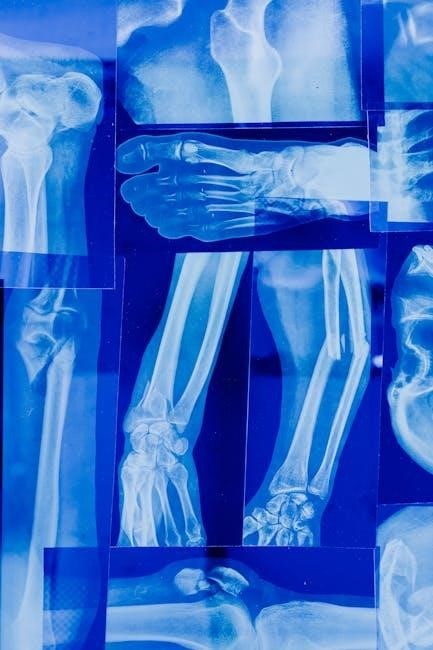
skeletal system pdf worksheets
Skeletal system PDF worksheets are educational tools designed to help students learn about the human skeletal structure and its functions through interactive activities. These worksheets offer engaging exercises like labeling diagrams, solving crossword puzzles, and completing fill-in-the-blanks to enhance understanding. They cater to various age groups, providing a versatile learning experience for both kids and advanced learners. Perfect for classrooms or homeschooling, these resources make anatomy education accessible and fun.
1.1. What Are Skeletal System Worksheets?
Skeletal system worksheets are educational resources designed to teach students about the human skeletal structure through interactive activities. These worksheets typically include exercises like labeling diagrams, identifying bones, and completing fill-in-the-blanks. They cover topics such as bone functions, joints, and the difference between axial and appendicular skeletons. Available in PDF format, these worksheets are easy to download and print, making them ideal for classroom or homeschool use. They cater to various age groups, providing a hands-on learning experience that makes anatomy engaging and accessible for students of all levels.
1.2. Importance of Using Worksheets for Learning
Worksheets are essential tools for engaging students in active learning, promoting better retention of skeletal system concepts. They offer structured exercises that enhance understanding through hands-on activities like labeling, crossword puzzles, and fill-in-the-blanks. Worksheets cater to different learning styles, fostering visual, tactile, and cognitive engagement. They also help develop fine motor skills and literacy while providing a clear framework for students to organize their knowledge. Regular use of worksheets ensures consistent practice, reinforcing key topics and preparing students for more advanced studies. They are particularly effective for visual learners, making complex anatomical concepts accessible and fun to explore.

Educational Value of Skeletal System Worksheets
Skeletal system worksheets enhance learning by providing interactive exercises that improve knowledge retention and understanding of bone structure and function. They offer visual and hands-on activities, making complex concepts engaging and accessible for students of all ages.
2.1. Functions of the Skeletal System
The skeletal system performs essential functions vital for the human body. It provides structural support, protecting internal organs like the brain and heart. Bones act as attachment points for muscles, enabling movement. The skeletal system also stores minerals such as calcium and phosphorus, supporting overall health. Additionally, it produces blood cells in bone marrow, crucial for immune function and oxygen transport. Bones further store energy in the form of fat within yellow marrow. Understanding these functions is fundamental for appreciating the skeletal system’s role in maintaining life and enabling bodily activities.
2.2. Bone Structure and Composition
Bones are composed of compact and spongy bone tissue, providing strength and flexibility. Compact bone forms the outer layer, while spongy bone is found inside, containing bone marrow. Haversian canals in compact bone facilitate nerve and blood supply. The periosteum, a protective membrane, covers the bone surface. Bones also contain collagen for flexibility and calcium phosphate for hardness. Understanding bone structure is key to learning how the skeletal system functions, with worksheets often featuring diagrams and labeling exercises to help students identify these components and their roles in overall health and movement.

Types of Skeletal System Worksheets
Skeletal system worksheets come in various forms, including labeling exercises, crossword puzzles, fill-in-the-blanks, and bone identification activities. These interactive tools cater to different learning styles and age groups, making anatomy education engaging and accessible for students of all levels. Each type of worksheet is designed to reinforce understanding of bone structure, function, and classification, ensuring a comprehensive learning experience through visual and hands-on activities.
3.1. Labeling the Skeleton
Labeling the skeleton is a fundamental activity in skeletal system worksheets, designed to help students identify and learn the names of major bones. These exercises often feature diagrams of the human skeleton with blank spaces for students to fill in the correct bone names. Interactive and educational, labeling worksheets cater to visual learners and reinforce memory retention. They are suitable for all age groups, from young children learning basic bone names to advanced students studying complex anatomy. This hands-on approach makes learning engaging and ensures a solid understanding of skeletal structure and terminology.
3.2. Crossword Puzzles and Word Searches
Crossword puzzles and word searches are engaging components of skeletal system worksheets, designed to make learning fun and interactive. These activities help students familiarize themselves with key terms like “humerus,” “femur,” and “cartilage.” Word searches often hide vocabulary related to bones and joints, encouraging students to locate and remember terms. Crosswords challenge learners to define anatomical concepts, reinforcing their understanding of skeletal functions. These exercises are suitable for all age groups, from elementary to high school, and are easily downloadable in PDF format. They provide an entertaining way to master skeletal system terminology while promoting critical thinking and problem-solving skills.
3.3. Fill-in-the-Blank Exercises
Fill-in-the-blank exercises are a popular feature in skeletal system PDF worksheets, allowing students to practice recalling key terms and concepts. These exercises often focus on identifying bones, functions of the skeletal system, and related anatomical terms like “bone marrow” and “cartilage.” Designed for various age groups, they provide a structured way to reinforce learning. Fill-in-the-blank activities are easy to use, making them ideal for classroom or homeschooling settings. They help students build confidence in their understanding of skeletal anatomy while developing essential writing and recall skills. These exercises are commonly included in free printable worksheets available online.
3.4. Bone Identification Activities
Bone identification activities in skeletal system PDF worksheets help students recognize and name different bones in the human body. These exercises often include labeled diagrams or matching games where students connect bone names to their corresponding images. Interactive activities, such as puzzles or 3D model-building, enhance hands-on learning. Some worksheets feature cross-sections of bones, allowing students to identify structures like compact bone, spongy bone, and Haversian canals. These exercises are particularly useful for middle and high school students, providing a practical way to master bone anatomy and prepare for advanced studies in biology or anatomy. They are widely available in free printable resources online.

Skeletal System Worksheets for Different Age Groups
Skeletal system PDF worksheets are tailored for various age groups, offering age-appropriate activities. Preschoolers enjoy coloring pages, while older students engage with crossword puzzles and fill-in-the-blanks, enhancing their learning experience.
4.1. Worksheets for Preschool and Kindergarten

Preschool and kindergarten skeletal system worksheets are designed for young learners, focusing on basic concepts through fun, interactive activities. These include coloring pages, simple puzzles, and matching games that introduce bone names and skeletal structure. Activities like labeling large, simplified diagrams help develop fine motor skills and hand-eye coordination. Worksheets often feature engaging visuals and easy-to-understand language, making learning about the skeletal system accessible and enjoyable for early learners. These resources are perfect for introducing anatomy in a playful, age-appropriate manner, sparking curiosity and laying the foundation for future science education.
4.2. Worksheets for Elementary School Students
Elementary school skeletal system worksheets are tailored for students in grades 1-5, offering engaging and educational activities to deepen their understanding of human anatomy. These worksheets typically include simplified bone labeling exercises, crossword puzzles, and fill-in-the-blank questions. They often feature illustrations of the human skeleton and basic diagrams to help students identify major bones and their functions. Interactive elements like word searches and matching games make learning fun while reinforcing key concepts. These resources are designed to align with elementary science curricula, providing a foundational knowledge of the skeletal system in an accessible and visually appealing format.
4.3. Worksheets for Middle and High School Students
Worksheets for middle and high school students offer advanced learning tools to explore the skeletal system in depth. These resources often include detailed bone structure diagrams, case studies on fractures, and exercises on joint functions. Students can engage in activities like identifying the axial and appendicular skeleton, analyzing bone marrow roles, and solving puzzles related to skeletal anatomy. Designed to align with higher-level science curricula, these worksheets incorporate critical thinking exercises and real-world applications, preparing students for advanced biology and anatomy studies while reinforcing their understanding of complex skeletal system concepts.

Interactive and Hands-On Activities
Interactive activities like puzzles, coloring pages, and build-your-own-skeleton projects make learning engaging. These hands-on exercises help students visualize and retain information about the skeletal system effectively.
5.1. Build-Your-Own-Skeleton Projects
Build-your-own-skeleton projects are engaging activities where students assemble life-sized skeletons using printable bone templates. These exercises help reinforce bone identification and the skeletal system’s structure. By cutting out and organizing bones, students develop fine motor skills and spatial awareness. This hands-on approach makes complex anatomy concepts accessible and memorable. Perfect for classrooms or homeschooling, these projects often include educational facts and diagrams, encouraging interactive learning. They are especially popular during Halloween, adding a fun element to anatomy education while promoting deeper understanding of the human skeleton.
5.2. Bone Coloring Pages

Bone coloring pages are a fun and creative way for students to engage with the skeletal system. These printable PDFs feature detailed illustrations of bones, allowing learners to color and label them. Coloring helps reinforce bone identification and understanding of their shapes and functions. Suitable for all ages, these pages enhance fine motor skills and hand-eye coordination in younger students while providing a relaxing yet educational activity for older learners. They are versatile tools that can be used in classrooms, homeschooling, or as supplementary materials, making anatomy learning both enjoyable and accessible.
5.3. Skeletal System Puzzles
Skeletal system puzzles are interactive learning tools that help students engage with bone structures and their relationships. These puzzles often include jigsaw-style activities where learners assemble skeletons or match bones to their correct locations. They enhance spatial awareness and critical thinking while reinforcing knowledge of anatomy. Available in PDF formats, these puzzles are easy to print and customize, catering to different age groups and learning styles. Puzzles like “Build-Your-Own-Skeleton” encourage hands-on learning, making complex concepts fun and accessible. They are ideal for visual and kinesthetic learners, promoting active participation in the learning process. Regular use can improve retention of skeletal system details.

Key Topics Covered in Skeletal System Worksheets
Skeletal system worksheets cover essential topics like the axial and appendicular skeleton, types of joints, and bone marrow and cartilage. These resources help students understand skeletal functions and structures through detailed diagrams and exercises.
6.1. Axial and Appendicular Skeleton
The axial skeleton includes the skull, vertebral column, ribcage, and sternum, forming the body’s central framework. The appendicular skeleton comprises the upper and lower limbs, shoulders, and pelvis, enabling movement and support. Worksheets often feature labeled diagrams to distinguish these two systems, helping students understand their roles and structures. Interactive exercises, such as matching games, reinforce the differences between axial and appendicular bones, making learning engaging and effective for anatomy education.
6.2. Types of Joints and Their Functions
Joints are essential for movement, connecting bones and enabling flexibility. The skeletal system worksheets often include exercises to identify and describe joint types, such as ball-and-socket, hinge, pivot, gliding, saddle, and plane joints. Ball-and-socket joints, like the shoulder and hip, allow wide-range motion, while hinge joints, such as the elbow and knee, permit movement in one direction. Pivot and gliding joints provide rotational and sliding movements, respectively. Saddle joints, found in the wrist and ankle, offer limited movement. Worksheets often feature diagrams and fill-in-the-blank exercises to help students understand joint functions and their roles in mobility and stability.
6.3. Bone Marrow and Cartilage
Bone marrow is a spongy tissue within bones responsible for producing blood cells and storing energy as fat. Red bone marrow produces blood cells, while yellow marrow stores fat for energy. Cartilage, a flexible connective tissue, cushions joints, supports movement, and is found in areas like the ears, nose, and between bones. Worksheets often include labeling exercises to identify bone marrow locations and cartilage types, such as hyaline, elastic, and fibrocartilage. These activities help students understand how bone marrow supports blood production and how cartilage facilitates smooth joint movements, enhancing overall knowledge of skeletal system functions and structures.

Benefits of Using PDF Worksheets
Skeletal system PDF worksheets are easy to download, print, and share, making them highly accessible for educational use. They offer reusable, high-quality visuals and diagrams, ensuring consistent learning experiences across different settings.
7.1. Easy to Download and Print
Skeletal system PDF worksheets are readily available online, making them easy to download and print. Many websites offer free access to these resources, requiring only a few clicks to obtain. They are compatible with various devices, ensuring convenience for educators and students alike. Printing is straightforward, as most worksheets are designed to fit standard paper sizes. This accessibility allows teachers to quickly prepare materials for lessons or homework, saving time and effort. The ease of downloading and printing makes skeletal system PDF worksheets a practical choice for both classroom and homeschooling environments.
7.2. Reusable and Shareable
Skeletal system PDF worksheets are highly reusable and shareable, making them a valuable resource for educators. Once downloaded, these files can be printed multiple times for different students or class sessions. Teachers can easily distribute them via email or online platforms, ensuring accessibility for all learners. Their digital format also allows for sharing among colleagues, fostering collaboration. Additionally, students can reuse worksheets for revision purposes, enhancing their learning experience. This reusability and shareability make skeletal system PDF worksheets a cost-effective and efficient tool for teaching and learning anatomy.
7.3. High-Quality Visuals and Diagrams
Skeletal system PDF worksheets often include high-quality visuals and diagrams, making complex anatomical concepts easier to understand. Detailed illustrations of bones, joints, and the skeletal structure provide students with a clear visual reference. These diagrams are particularly helpful for labeling exercises, allowing learners to identify and name different parts of the skeleton accurately. The visuals are designed to be engaging and informative, catering to various learning styles. Cross-sections of bones, 3D models, and comparative illustrations enhance the educational experience, ensuring students grasp both the structure and function of the skeletal system effectively.

How to Use Skeletal System Worksheets Effectively
Incorporate skeletal system worksheets into lesson plans for structured learning, assign them as homework for independent practice, and supplement with interactive activities to enhance engagement and retention.
8.1. Incorporating Worksheets into Lesson Plans
Incorporating skeletal system worksheets into lesson plans enhances structured learning by providing hands-on activities aligned with curriculum goals. Teachers can introduce labeling exercises for visual learners, crossword puzzles for vocabulary building, and fill-in-the-blanks to reinforce key concepts. These worksheets can be used during classroom discussions or as independent practice to ensure comprehension. For younger students, coloring pages and bone identification activities make learning engaging and interactive. Varying worksheet types caters to different learning styles, ensuring all students benefit. Regular use of these resources fosters improved engagement and understanding of the skeletal system in a classroom setting.
8.2. Using Worksheets for Homework Assignments
Using skeletal system worksheets as homework assignments provides students with practical exercises to reinforce classroom learning. Teachers can assign labeling activities, crossword puzzles, or fill-in-the-blanks to ensure students apply their knowledge at home. These worksheets cater to different learning styles, helping students retain information effectively. Homework assignments also allow parents to monitor progress and engage with their child’s education. PDF worksheets are easy to distribute and review, making them a convenient tool for reinforcing skeletal system concepts outside the classroom. Regular homework assignments with these resources help build a strong foundation in anatomy and prepare students for future lessons.
8.3. Enhancing Learning with Interactive Activities
Interactive activities are a powerful way to engage students and deepen their understanding of the skeletal system. Worksheets that incorporate puzzles, coloring pages, and build-your-own-skeleton projects encourage hands-on learning. These activities make complex concepts more accessible and fun, fostering creativity and critical thinking. For instance, bone identification exercises and cross-section labeling help students visualize bone structures. Interactive PDFs with clickable features or animations can further enhance learning. By combining visual, tactile, and cognitive elements, these activities create a comprehensive and memorable educational experience, ensuring students develop a strong grasp of the skeletal system in an enjoyable manner.
Popular Resources for Skeletal System Worksheets
Popular resources include websites like Homemade Heather, Ask A Biologist, and KidsHealth.org, offering free printable PDFs with skeletal system activities, puzzles, and labeling exercises for all ages.
9.1. Free Printable Worksheets Online
Free printable skeletal system worksheets are widely available online, offering a variety of activities for all learning levels. Websites like Homemade Heather and Ask A Biologist provide downloadable PDFs featuring bone labeling, crossword puzzles, and fill-in-the-blank exercises. These resources are ideal for teachers, homeschoolers, and students seeking interactive learning tools. Many sites also include coloring pages and puzzles, making anatomy education engaging and accessible for kids. With just a few clicks, users can access high-quality materials to enhance their understanding of the skeletal system.
9.2. Educational Websites and Blogs
Educational websites and blogs are excellent sources for skeletal system PDF worksheets, offering a wide range of free and high-quality resources. Platforms like Homemade Heather provide engaging printables, including bone-labeling activities, crossword puzzles, and coloring pages. These websites cater to various age groups, from preschool to high school, ensuring that learners at every level can benefit. Many blogs also feature detailed guides and tips for educators to incorporate these worksheets into lesson plans effectively. By leveraging these online resources, teachers and students can access comprehensive and interactive learning materials for anatomy education.
9.3. Workbooks and Classroom Materials
Skeletal system workbooks and classroom materials offer comprehensive resources for structured learning. These materials often include detailed diagrams, activity sheets, and exercises tailored for different grade levels. Workbooks provide in-depth exploration of bone structure, functions, and related systems, while classroom sets ensure every student has access to hands-on activities. Many workbooks are designed to align with curriculum standards, making them ideal for teachers seeking to integrate skeletal system studies into their lesson plans. Additionally, these materials often include answer keys and teaching guides, supporting educators in delivering effective anatomy lessons. They are versatile tools for both individual and group learning environments.
Skeletal system PDF worksheets are valuable educational tools that enhance learning through interactive activities, fostering a deeper understanding of anatomy. They provide accessible, engaging resources for all learners.
10.1. The Impact of Worksheets on Learning
Skeletal system PDF worksheets significantly enhance learning by providing interactive and structured activities that improve retention and engagement. They cater to diverse learning styles, offering visual, tactile, and cognitive exercises. Worksheets encourage active participation, making complex anatomical concepts accessible. For younger learners, they develop fine motor skills and literacy, while older students benefit from in-depth review and critical thinking challenges. Their versatility allows educators to tailor lessons to different age groups, ensuring comprehensive understanding. By fostering hands-on learning, these resources create a lasting impact on students’ grasp of the skeletal system and its functions. They are invaluable tools for effective anatomy education.
10.2. Encouraging Further Exploration of the Skeletal System
Skeletal system PDF worksheets inspire curiosity and motivate students to explore anatomy beyond the classroom. Interactive activities like labeling, puzzles, and build-your-own-skeleton projects make learning engaging and fun. These resources cater to various learning styles, encouraging students to delve deeper into the subject. By completing these exercises, learners gain confidence and a sense of accomplishment, fostering a desire to discover more about the skeletal system. Additionally, the availability of free, printable worksheets makes it easy for students to continue their exploration independently, sparking a lifelong interest in human anatomy and its fascinating structures.